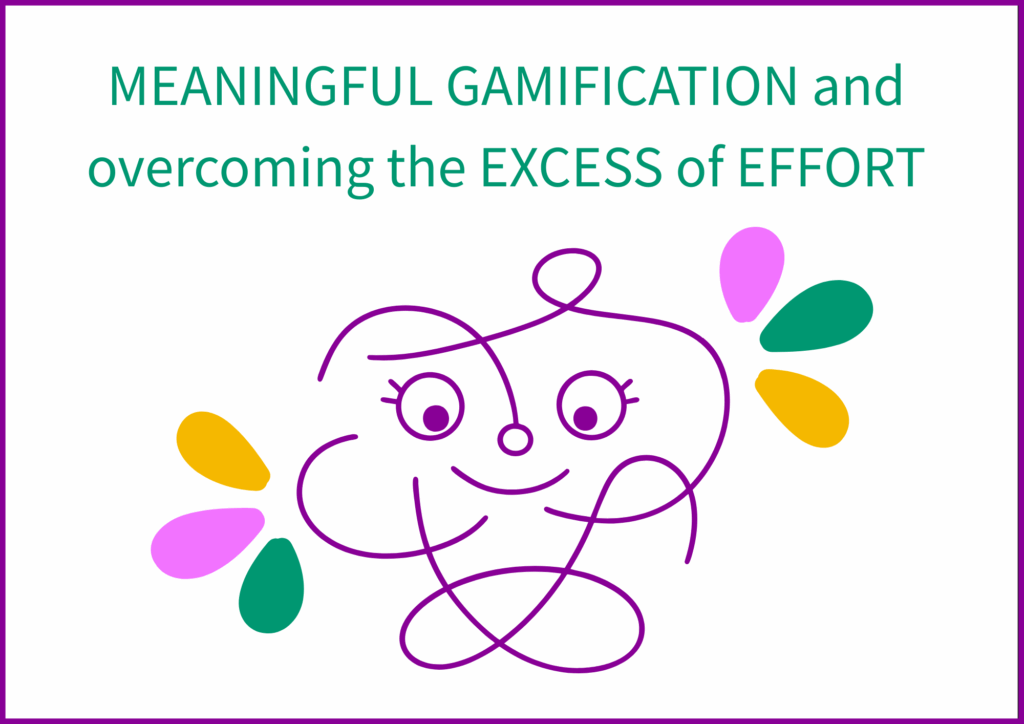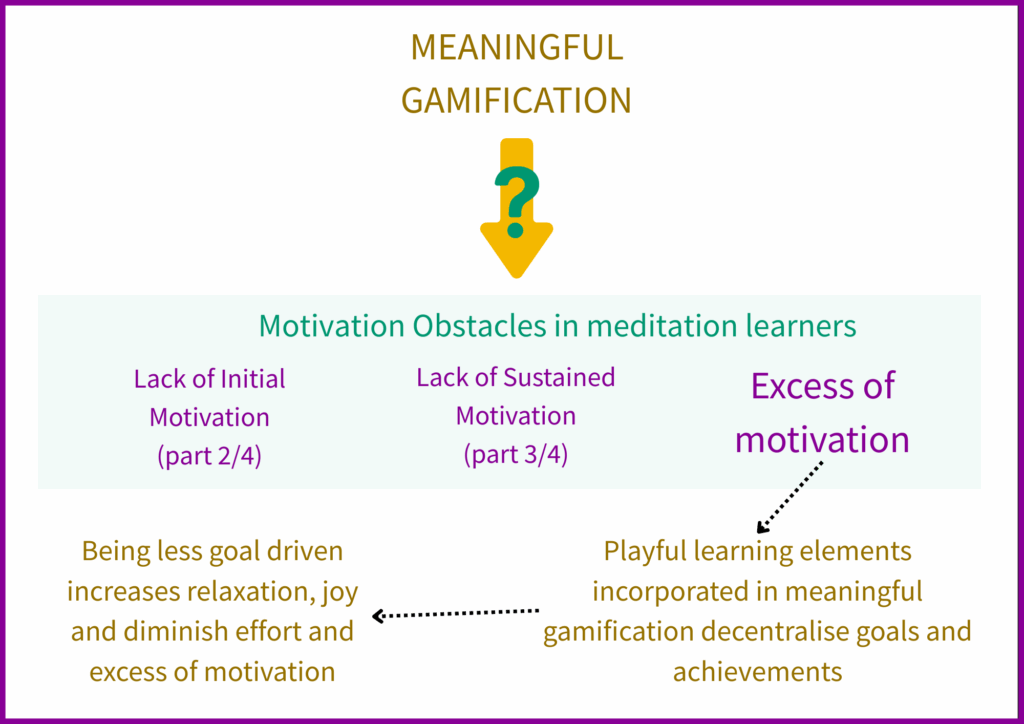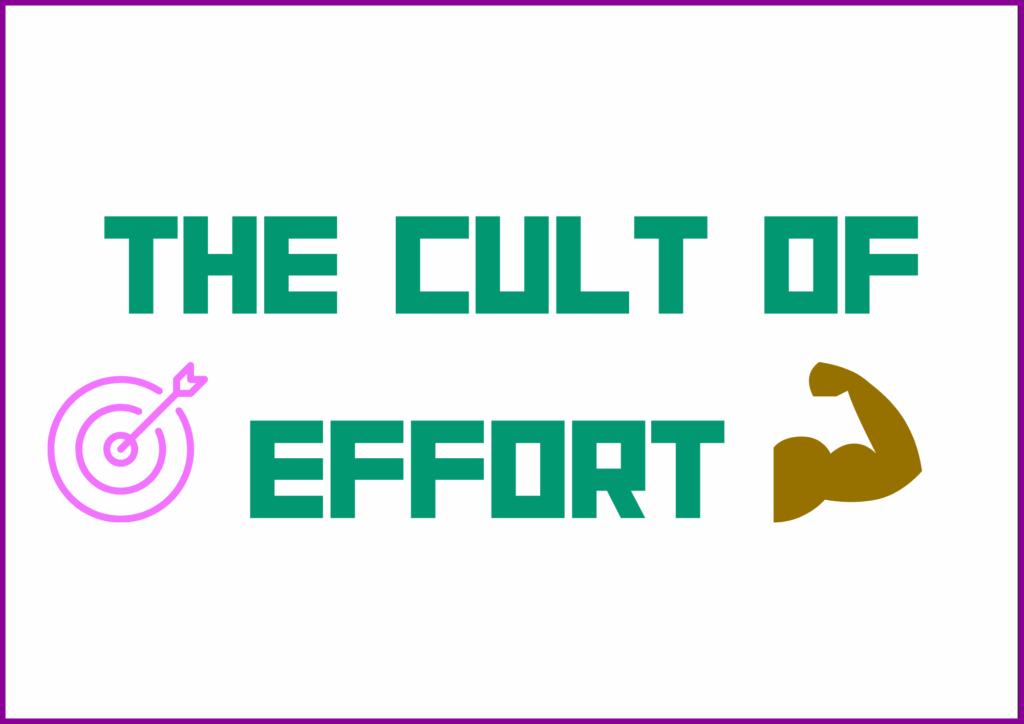Gamification, Presence and Awareness (Part 4/4)

As we discussed in our explanation, the process of meditation is based on the principle of balance between attention and relaxation, of being motivated enough but not to the extent of being too tense and too goal focused. This is a much more difficult exploration due to a lack of peer reviewed articles in terms of ‘too much effort and motivation’ obstacles.
What Wuyts (2020) describes as ‘excess to exhaustion’ might point out towards the reason for this lack of research, in a society oriented towards goal achievement and the cult and praise of effort in which play is absent (Nørgård, Toft-Nielsen & Whitton, 2017).
Giving too much effort is nonetheless a major issue when it comes to meditation, and I would like to try gaining some insight to see if meaningful gamification can help overcome this excess of effort or motivation.
Mullins and Sabherwal (2018) focused specifically on the effect of gamification on emotion and particularly show that emotions such as enjoyment and relaxation are at the very core of gamification. Likewise, Kapp (2012) explains that when gamification is intended for intrinsic motivation, the tension that comes with competition, comparison, and external rewards leave the space for what he calls effortless learning. In other words, Kapp encourages the mindset of the learner to be oriented towards open play rather than being task-oriented and goal-oriented.
To explore more this notion of play, I found it useful to look at a pedagogy called Playful Learning and how the elements of this pedagogy could be merged with meaningful gamification. Playful learning is characterized by a pedagogy fostering a state of mind where there is a joy in being engaged in an activity without the need to achieve or succeed at anything (Whitton & Moseley, 2019). This is a crucial element in terms of creating an environment of play: removing the emphasis on the goal, on achieving, succeeding and simply orienting the learners into the enjoyment of the learning and task itself.

An example of an implementation of this approach in terms of gamification for meditation was the MindJourney’s project (Ge & Han, 2021). MindJourney is a game based on biofeedback, Virtual Reality and gamification. In this game, the creators have been mindful of not creating any external rewards and judgement on performance. Learners are in a virtual world full of fog and some exploration needs to take place. When they relax their breathing, the fog diminishes, and they access more information about their exploration. They continue to navigate the virtual world by maintaining an awareness of their breathing. They see the direct correlation between their breathing pattern and what they are experiencing in the game. The results show a positive correlation between the use of these innovative pedagogies and technologies and the development of meditation by being aware of being less goal oriented.

Conclusion
As a conclusion I would like to summarise the findings of this research. Firstly, I explained the context of our learners and discovered that exploring this context with meaningful gamification through the keystone of motivation can offer some documented insight into our inquiry.
Motivation issues in meditation can be of three types. Initial motivation can be easily overcome through gamification. Sustained motivation, however, is best nurtured through meaningful gamification, which gives an emphasis to fostering intrinsic motivation and real-world connections. Excess motivation, which in our context means being too goal driven, can also be overcome through meaningful gamification that takes into account elements of playful learning.
This reasoning however has been done through indirect means as I have found no scholarly nor non-scholarly study on the impact of meaningful gamification towards learning deconstructive meditation. Further research needs to take place in this specialized field. As a conclusion of this inquiry, I will generate my own research based on my findings. The research will collect data from learners through various assessment tasks during the meditation course that I will design. I will display the results in another blog when the research is completed.
Go back to Gamification, Presence and Awareness (Part 3/4)
References:
Alsawaier, R. S. (2018). The effect of gamification on motivation and engagement. The International Journal of Information and Learning Technology, 35(1), 56-79.
Amaro, A. (2018). ‘I’m Not Getting Anywhere with my Meditation…’: Effort, Contentment and Goal-directedness in the Process of Mind-training. Buddhist Studies Review, 35(1-2), 47-64.
Britton WB, Lindahl JR, Cahn BR, Davis JH, Goldman RE. (2014). Awakening is not a metaphor: the effects of Buddhist meditation practices on basic wakefulness. Ann N Y Acad Sci. Jan;1307:64-81. doi: 10.1111/nyas.12279.
Brown, K. W., Berry, D., Eichel, K., Beloborodova, P., Rahrig, H., & Britton, W. B. (2022). Comparing impacts of meditation training in focused attention, open monitoring, and mindfulness‐based cognitive therapy on emotion reactivity and regulation: neural and subjective evidence from a dismantling study. Psychophysiology, 59(7), e14024.
Chapman, J. R., Kohler, T. B., Rich, P. J., & Trego, A. (2025). Maybe we’ve got it wrong. An experimental evaluation of self-determination and Flow Theory in gamification. Journal of Research on Technology in Education, 57(2), 417-436.
Coquillard, A. (2024). Assessment task 1 – Literature review in educational design graduate certificate unit EDF5768 – Educational design. Monash University.
Coquillard, A. (2025). Assessment task 1 – Compendium in educational design graduate certificate unit EDF5772 – Innovations in technologies and pedagogical practices. Monash University.
Dahl, C. J., Lutz, A., & Davidson, R. J. (2015). Reconstructing and deconstructing the self: cognitive mechanisms in meditation practice. Trends in cognitive sciences, 19(9), 515-523.
Donald, J. N., Bradshaw, E. L., Ryan, R. M., Basarkod, G., Ciarrochi, J., Duineveld, J. J., … & Sahdra, B. K. (2020). Mindfulness and its association with varied types of motivation: A systematic review and meta-analysis using self-determination theory. Personality and Social Psychology Bulletin, 46(7), 1121-1138.
Galla, B. (2024). How motivation restricts the scalability of universal school‐based mindfulness interventions for adolescents. Child Development Perspectives, 18(3), 129-136
Ge, Y., & Han, T. (2021). MindJourney: Employing gamification to support mindfulness practice. In Advances in Usability, User Experience, Wearable and Assistive Technology: Proceedings of the AHFE 2021 Virtual Conferences on Usability and User Experience, Human Factors and Wearable Technologies, Human Factors in Virtual Environments and Game Design, and Human Factors and Assistive Technology, July 25-29, 2021, USA (pp. 228-235). Springer International Publishing.
Kabat-Zinn, J. (2017). Common obstacles to practice. Mindfulness, 8(6), 1713-1715.
Kapp, K. M. (2012). The gamification of learning and instruction: game-based methods and strategies for training and education. John Wiley & Sons.
Karadjova, K. (2018). Mindfulness and gamification in the higher education classroom: Friends or foes?. In 4th International Conference on Higher Education Advances (HEAD’18) (pp. 1089-1097). Editorial Universitat Politècnica de València.
Krishnamurti, J. (1956). Education and the significance of life. New-York: Haper Collins publishers.
Li, L., Hew, K. F., & Du, J. (2024). Gamification enhances student intrinsic motivation, perceptions of autonomy and relatedness, but minimal impact on competency: a meta-analysis and systematic review. Educational technology research and development, 72(2), 765-796.
Li, M., Ma, S., & Shi, Y. (2023). Examining the effectiveness of gamification as a tool promoting teaching and learning in educational settings: a meta-analysis. Frontiers in Psychology, 14, 1253549
Ling, L. T. Y. (2018). Meaningful Gamification and Students’ Motivation: A Strategy for Scaffolding Reading Material. Online Learning, 22(2), 141-155.
Malone, T. W., & Lepper, M. R. (2021). Making learning fun: A taxonomy of intrinsic motivations for learning. In Aptitude, learning, and instruction (pp. 223-254). Routledge.
Mullins, J. K., & Sabherwal, R. (2018). Beyond enjoyment: a cognitive-emotional perspective of gamification.
Nicholson, S. (2015). A recipe for meaningful gamification. Gamification in education and business, 1-20.
Norbu, C. N. (2013). The Mirror: Advice on Presence and Awareness (dran pa dang shes bzhin gyi gdams pa me long ma). Religions, 4(3), 412-422.
Ramírez-Barrantes, R., Arancibia, M., Stojanova, J., Aspé-Sánchez, M., Córdova, C., & Henríquez-Ch, R. A. (2019). Default Mode Network, Meditation, and Age‐Associated Brain Changes: What Can We Learn from the Impact of Mental Training on Well‐Being as a Psychotherapeutic Approach?. Neural Plasticity, 2019(1), 7067592.
Rivera, E. S., & Garden, C. L. P. (2021). Gamification for student engagement: a framework. Journal of further and higher education, 45(7), 999-1012.
Sailer, M., & Homner, L. (2020). The gamification of learning: A meta-analysis. Educational psychology review, 32(1), 77-112.
Tan, M., & Hew, K. F. (2016). Incorporating meaningful gamification in a blended learning research methods class: Examining student learning, engagement, and affective outcomes. Australasian Journal of Educational Technology, 32(5).
Tanrıkulu, G., & Demirel, B. (2023). Gamification in Mindfulness Mobile Applications: The Effects of Rewards on Purchase Intention. Optimum Ekonomi ve Yönetim Bilimleri Dergisi, 10(1), 125-142.
Thomma, N. (2025). Gamified Mindfulness: A Novel Approach to Nontraditional Meditation (Bachelor’s thesis, University of Twente)
Wang, C. J., Liu, W. C., Kee, Y. H., & Chian, L. K. (2019). Competence, autonomy, and relatedness in the classroom: understanding students’ motivational processes using the self-determination theory. Heliyon, 5(7).
Whitton, N., & Moseley, A. (2019). Playful learning. Events and activities to engage adults. New York.
Wuyts, P. (2020). From Excess to Exhaustion: The Rise of Burnout in a Post-modern Achievement Society. In Perception and the Inhuman Gaze (pp. 205-217). Routledge
Xi, N., & Hamari, J. (2019). Does gamification satisfy needs? A study on the relationship between gamification features and intrinsic need satisfaction. International Journal of Information Management, 46, 210-221.
Yavuz Sercekman, M. (2024). Exploring the sustained impact of the Mindfulness-Based Stress Reduction program: a thematic analysis. Frontiers in Psychology, 15, 1347336.
